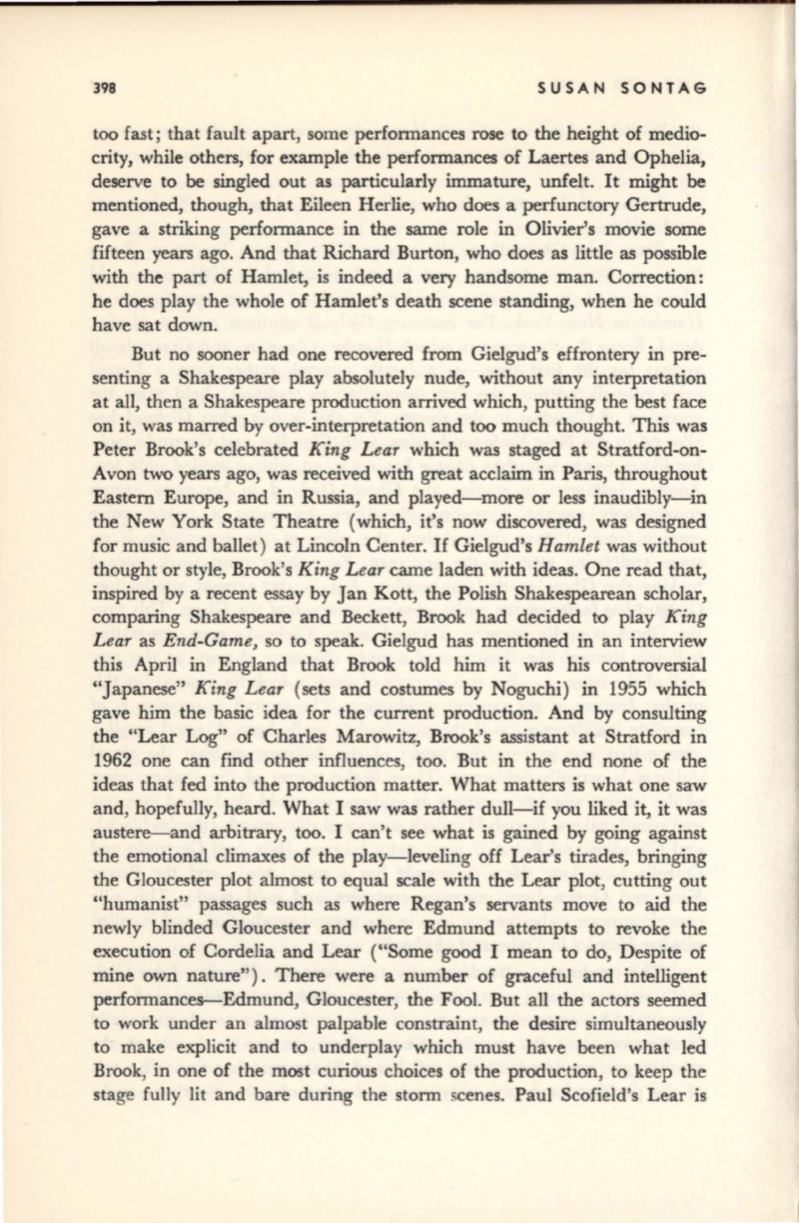
398
SUSAN SONTAG
too fast; that fault apart, some performances rose to the height of medio–
crity, while others, for example the performances of Laertes and Ophelia,
deserve to be singled out as particularly immature, unfelt. It might be
mentioned, though, that Eileen Herlie, who does a perfunctory Gertrude,
gave a striking performance in the same role in Olivier's movie some
fifteen years ago. And that Richard Burton, who does as little as possible
with the part of Hamlet, is indeed a very handsome man. Correction:
he does play the whole of Hamlet's death scene standing, when he could
have sat down.
But no sooner had one recovered from Gielgud's effrontery in pre–
senting a Shakespeare play absolutely nude, without any interpretation
at all, then a Shakespeare production arrived which, putting the best face
on it, was marred by over-interpretation and too much thought. This was
Peter Brook's celebrated
King Lear
which was staged at Stratford-on–
Avon
two
years ago, was received with great acclaim in Paris, throughout
Eastern Europe, and in Russia, and played-more or less inaudibly-in
the New York State Theatre (which, it's now discovered, was designed
for music and ballet) at Lincoln Center.
If
Gielgud's
Hamlet
was without
thought or style, Brook's
King Lear
came laden with ideas. One read that,
inspired by a recent essay by Jan Kott, the Polish Shakespearean scholar,
comparing Shakespeare and Beckett, Brook had decided
to
play
King
Lear
as
End-Game,
so to speak. Gielgud has mentioned in an interview
this April in England that Brook told him it was his controversial
"Japanese"
King Lear
(sets and costumes by Noguchi) in 1955 which
gave him the basic idea for the current production. And by consulting
the "Lear Log" of Charles Marowitz, Brook's assistant at Stratford in
1962 one can find other influences, too. But in the end none of the
ideas that fed into the production matter. What matters is what one saw
and, hopefully, heard. What I saw was rather dull- if you liked it, it was
austere-and arbitrary, too. I can't see what is gained by going against
the emotional climaxes of the play-leveling off Lear's tirades, bringing
the Gloucester plot almost to equal scale with the Lear plot, cutting out
"humanist" passages such as where Regan's servants move to aid the
newly blinded Gloucester and where Edmund attempts to revoke the
execution of Cordelia and Lear ("Some good I mean to do, Despite of
mine own nature"). There were a number of graceful and intelligent
performances--Edmund, Gloucester, the Fool. But all the actors seemed
to work under an almost palpable constraint, the desire simultaneously
to make explicit and to underplay which must have been what led
Brook, in one of the most curious choices of the production, to keep the
stage fully lit and bare during the storm scenes. Paul Scofield's Lear is


